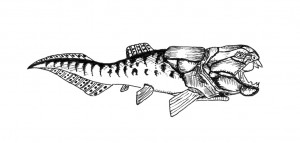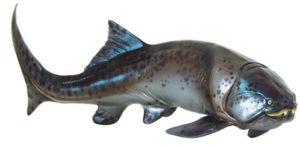The Jaws of Placoderms The Origins of Teeth
The First Jaws with Teeth – Scientists Identify The Toothy Grin of the Placoderms
An international team of researchers have used high powered X-rays to look inside the mouths of an ancient group of fishes and discovered that some of these marine creatures had teeth, whose structure was very similar to our own teeth. With the development of teeth, these fish had an evolutionary advantage over other marine animals and teeth capable of biting would have upped the evolutionary arms race between hunter and the hunted accelerating other evolutionary adaptations and developments.
Fish Fossils
Fish fossils from a rock formation, known as the Go Go Formation (Kimberley region, Western Australia) had been collected by scientists ever since this fossil rich area was discovered more than seventy years ago. The strata represents a reef environment in a warm, shallow tropical sea that existed in the Late Devonian geological period (approximately 380 million years ago – Frasnian faunal stage).
A wide variety of Devonian fish specimens have been collected from this location, including many placoderms. Placoderms were a highly successful and diverse clade of fish that had primitive jaws. The name “placoderm” means plated skins as these nektonic animals had broad, flat bony plates over the head and the front of their bodies, protection against attack from other predatory fish and eurypterids (sea scorpions).
Palaeontologists have classified the Placodermi into seven main groups, it is fish fossils from one such group that show signs of modern teeth in this new study.
An Illustration of a Typical Placoderm
Picture credit: Everything Dinosaur
The Jaws of Placoderms
It has long been believed that teeth are highly modified fish scales, although it has been hotly debated how teeth with a pulp canal, dentine and an outer surface made of enamel like our teeth first evolved. Placoderms had jaws but until now it was not thought that they had teeth-like structures. This particular group of fish probably had a skeleton made of cartilage, indicating that they may share a common ancestor with sharks and rays.
The jaws of most placoderms had self-sharpening bony plates that served as teeth. Placoderms evolved a pair of sharp bony plates that hung from the top jaw, whilst the edges of the lower jaw were also bony and razor sharp. These jaws could be closed together like a pair of self-sharpening shears.
A team of scientists led by researchers from Bristol University, in collaboration with Australian colleagues studied the fossilised remains of a particular type of placoderm, a member of one of the largest families that make up the placoderm clade, (Arthrodira), a species known as Compagopiscis croucheri using powerful X-ray tomographic microscopy. The X-rays are produced by a huge circular device known as a synchrotron. This machine, located in Switzerland, fires electrons round a circuit which is encased in powerful magnets.
Powerful X-rays are emitted and this permits scientists to see internal structures of fossil material without damaging the fossil material itself. The images generated showed teeth inside the jaws that consisted of dentine and bone with a distinct pulp cavity.
The scientists have concluded that teeth and jaws may have evolved simultaneously in the Arthrodira. The researchers suggest that more complicated teeth evolved within the gnathostomes (vertebrates with jaws) very soon after jaws themselves evolved.
Dr Kate Trinajstic, from Western Australia’s Curtin University, one of the scientists involved in the study explained that to determine whether teeth were present in the jaws of placoderms would have meant the destruction of the fossil material so that the internal structure could be studied, if conventional methods had been used.
She stated:
The problem has been that to look at teeth you have to look at internally and museum directors aren’t too fussed on the idea of cutting up their specimens.”
Professor Philip Donoghue (University of Bristol’s School of Earth Sciences) went onto add:
“This is solid evidence for the presence of teeth in these first jawed vertebrates and solves the debate on the origin of teeth.”
The Placodermi
The placoderms themselves were a very successful and diverse group of fishes during the Late Devonian, perhaps their success can be put down in part to their sophisticated jaws and nascent teeth. Some of the Arthrodires were apex predators, such as the giant Dunkleosteus that grew up to six metres in length.
Many placoderms adapted to freshwater environments and this group of fish were some of the first animals with backbones to adapt to living in freshwater. However, despite their adaptations, it seems that the toothy placoderms were doomed to extinction.
Very few fossils of these creatures are found in rocks dating from the very end of the Devonian geological period and it seems that by around 360 million years ago (beginning of the Carboniferous), these fish had become extinct.
In June 2008, scientists published remarkable evidence indicating that some types of placoderm my have given birth to live young (viviparous behaviour), to read more about this: Placoderm Parents.
A Model of Dunkleosteus
The model (above) is from the Age of Dinosaurs replica range from PNSO, to view this excellent range of prehistoric animal models: PNSO Age of Dinosaurs Models and Figures.



